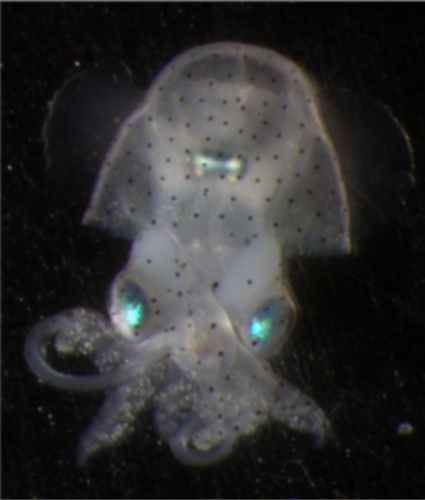Bacterial jousting among squid symbionts
Posted on March 10, 2023 by Dr Kirsten Guckes
Dr Kirsten Guckes takes us behind the scenes of her and her colleague Dr Tim I. Miyashiro's latest publication in Microboiology, 'The type-VI secretion system of the beneficial symbiont Vibrio fischeri'.
Can you introduce yourself, your role and your research area?
I am Dr Kirsten Guckes, a postdoctoral fellow in the lab of Dr Tim I. Miyashiro, who is an Associate Professor of Biochemistry and Molecular Biology at Penn State University, USA. As a molecular microbiologist, I study how bacterial cells control the genes they express and the impact that has on the physiological traits that they exhibit. More specifically, I study how bacterial cells regulate the traits that enable competition with other cells to successfully establish symbiosis with a host.

What is your research about and why is it important?
The health of most animals is affected by their interactions with microorganisms. Despite the historical focus on harmful interactions caused by pathogens, interactions between bacteria and their animal host are often reciprocally beneficial. They form what is known as a mutualistic symbiosis. The bacteria, or symbionts, express the genes necessary to establish a healthy relationship with their host partner. Once the symbiosis is established, the bacteria are able to enjoy shelter and nutrients from the host. In return, they provide benefits such as proper development, protection from pathogenic microbes, and effective digestion.
The sites where bacteria colonize on or within the host are often densely packed with competitor cells that would also benefit being part of a symbiotic relationship. Therefore, bacteria have evolved weapons to cause direct damage to these competitors, and one such weapon is the type VI secretion system (T6SS). The T6SS is a nanomachine that works like a molecular lancet to puncture adjacent cells and deliver toxins that often adorn the spiked tip of the apparatus.
Investigating how the T6SS is regulated and how it functions is important to understand how symbioses are established. Bacterial cells that wield this weapon have the opportunity to kill their competitors and prevent them from associating with a host. There are many different types of bacteria that can be part of a symbiotic population, and the composition of those populations have massive impacts on the physiology and/or development of the animal host. The T6SS is one competitive mechanism that can shape symbiont populations, and thereby alter host health.
What inspired you to write this paper?
Because most symbioses involve drastically diverse bacterial symbionts, it can be difficult to tease apart how the T6SS affects symbiotic populations. Consequently, I investigate competition between symbionts in the context of a simple symbiosis between the Hawaiian bobtail squid and the bacterium Vibrio fischeri. V. fischeri provide light in the form of bioluminescence that the squid use as camouflage. This symbiosis occurs naturally between a single animal host and a single bacterial species, but each animal harbors multiple strains of V. fischeri. Not all V. fischeri strains have been shown to express a functional T6SS, but those that can have the ability to kill cells of competitor strains. This provides a platform to investigate how the T6SS affects which bacterial cells successfully establish symbiosis.
Multiple groups have been able to leverage the power of the squid-vibrio symbiosis to ask important questions about the T6SS in bacterial symbionts. This effort has produced many foundational observations that have been reported in a number of publications over the last 5 years. The Microbiology Society review enabled us to integrate and highlight these important findings, which will hopefully facilitate progress in the field.

What do you enjoy most about your job?
As a postdoc, I have participated in apprenticeship-style training to gain experience that I need to become a productive independent scientist and an effective scientific educator. The best part about my experience in the lab has been working with talented and enthusiastic undergraduate students. It has been a privilege to introduce students to scientific research and watch them develop skills and confidence as they gain ownership of their own scientific inquiry. Some of these students have made significant contributions to the work highlighted in the Microbiology Society review, which demonstrates the importance and capability of junior members of the scientific community.
You can read the paper 'The type-VI secretion system of the beneficial symbiont Vibrio fischeri.' in Microbiology.
